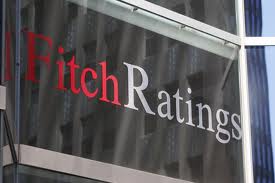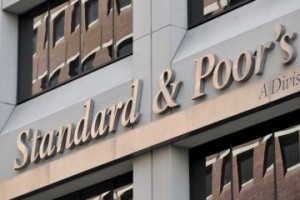Since the 25 January Revolution, Egypt’s economic outlook was downgraded several times by international credit rating agencies.
The downgrades came about due to violence and political instability, which took a massive toll on investments and foreign reserves.
In the wake of calls for protests on 30 June, Egypt’s economy saw a credit ratings cut on 21 March, when Moody’s Investors Service downgraded Egypt’s government bond ratings to Caa1 from B3. In May, Standard and Poor’s (S&P) lowered Egypt’s long-term credit rating to CCC+ from B-.
After former president Mohammed Morsi’s ouster, Egypt’s economic outlook began to revive when firstly S&P maintained the country’s long-term sovereign credit ratings in July 2013 at CCC+/C, with a “stable” outlook.

Fitch
Shortly after S&P’s ratings, and for the first time since 2011, Fitch Ratings agency in January 2014 upgraded Egypt’s economic outlook from negative to stable. It maintained its long-term foreign and local currency sovereign credit rating at B-, which accordingly reflects that Egypt’s economic risks are currently balanced.
Moody’s
In October, Moody’s raised Egypt’s credit ratings outlook to stable from negative, citing more stable political and security situation and signs of economic recovery.

It refrained from upgrading the credit rating, keeping it at Caa1, still one notch below S&P’s, saying government finances are still “too weak”.
Moody’s said that the constitutional referendum, presidential elections and parliamentary elections (likely to be held by early 2015), had provided a political reform roadmap and achieved institutional stability.
Moreover, Moody’s attributed the improved outlook to Egypt’s plans to phase out fuel and electricity subsidies, and measures to lift public revenues. The latter will be done by shifting to value added tax (VAT) system from a goods and services tax.
On 16 May, international rating agency S&P have affirmed Egypt’s long term and short-term foreign and local currency sovereign credit ratings, the agency announced in an official statement.
It put the country’s outlook at “stable”. S&P added that the affirmation reflects that official donors will continue to provide the Egyptian government sufficient foreign currency funds to manage the country’s short-term fiscal and external financing needs.
The agency said in a statement: “We expect ongoing support from official lenders over the next 12 months as the Egyptian authorities try to address the country’s political and economic challenges.”
The agency forecast that Egypt is expected to receive further support funds the Gulf Cooperation Council (GCC) states.
Economic Impacts
Ailing investments
The investment sector in Egypt was hammered by intermittent political instability throughout the last three years which have left Egypt’s economy in ruins. It is expected that this will form the basis of President Abdel Fattah Al-Sisi’s potential offer of a slew of projects to domestic and foreign investors at the Sharm El-Sheikh economic conference in March 2015.
Despite this, economic experts confirmed that the latest upgrades by the international credit ratings send a message to the world that Egypt has “become stable”. It will also have a significant impact in improving the investment index during the coming period. It is predicted this will occur in parallel with the visit of a technical delegation from the International Monetary Fund (IMF) to prepare a report on the country’s economic performance.
Karim Helal, Chairman of Adib Capital, Chairman of Asia Egypt Business Association, and member of the Egyptian Stock Exchange (EGX), said that the measures have both direct and indirect impact on the economic situation. Directly, the measures will reduce the borrowing cost of debts; indirectly, it will show a positive image to the investors that Egypt is on the right economic path.
Hesham Ibrahim, Economics Professor at Cairo University’s Faculty of Commerce, said, in comments to state-news agency MENA, that Egypt’s credit rating upgrade was perfectly timed to precede the IMF visit.
Ibrahim confirmed that the recent credit raising may improve Egypt’s overall assessment, and will play a pivotal role in its preparation for next year’s economic summit. It is hoped the summit will open up new investment avenues on the Egyptian market.
He pointed to the importance of reforming investment laws to overcome the obstacles investors may face ahead of the summit. This is particularly in attracting new investments for national projects including the Suez Canal axis, the Golden Triangle and the north-west coast developments, which need at least $2bn of foreign investments.
He emphasised the importance of find both diverse and new funding sources during the coming period to reduce the treasury deficit and the pressure on public investment to reduce debt.
Mohammad Najar, an expert at the Egyptian-European Partnership Fund, said that Al-Sisi’s recent decisions reflected on the stability of security and economic conditions. Najar said these contributed in raising the credit rating and aided in opening up new investment prospects.
He added that the decision to lift Egypt’s credit rating highlights the country’s ability to repay its debts, which could assist in pumping new foreign currency bonds in foreign stock markets again.
During the current fiscal year, Saudi Arabia, the UAE and Kuwait have pledged approximately $15bn, which according to S&P will help the country avoid balance-of-payment problems during the coming 12 months.
“Foreign investors should be reassured before investing in any country through many tools, mainly the indices of the international rating agencies, which is pivotal key for attracting investments,” said economics expert Magdy Toulba.
He said there are several other factors attracting investments, including a government investment strategy identifying important sectors.
Toulba added that the government should list tourism at the top of its investment agenda. This is especially so as it is one of the most vital sectors, with a strong tourist infrastructure and stunning attractions that could achieve short and long term profits for investors.
Minister of Planning Ashraf El-Araby said that the tourism sector and Suez Canal achieved positive growth during the first quarter of the current fiscal year. He said the Suez Canal achieved a growth of 9.1%, and industrial production exceeded 2%, while production reached 9.1%.
Chairman of the Economic Research Center of Sadat Academy for Management Sciences, Ibrahim Al-Dosoky, told private newspaper Saada Albalad that the current government needs to establish the “one shop” method for extracting operation permits and unify the owners of industrial areas to eliminate bureaucracy.
Growth rates
Speaking to Daily News Egypt, Fitch Director Paul Gamble said these measures will help in reducing the deficit as the combined savings and extra revenue are likely to cut it by 2-2.5% of GDP.
This compares to a GDP deficit in FY 2013-2014 of 12.1%, so there is still a long way to go. “It is also not clear whether some of the savings and additional revenue will be spent elsewhere. Strengthening economic activity will help lower the deficit, but it is expected to stay large for some time,” Gamble said.
According to Minister of Planning El-Araby, the targeted growth rate by the end of the current fiscal year of 3.5% will hopefully be surpassed to reach 3.8%.
El-Araby announced that the first quarter’s growth rate of FY 2014-2015 reached 1.1%. The figure was 6.8% higher than the same quarter last year, which registered 1% growth.
Growth during the first quarter of the FY 2013-2014 was 1%, and 1.4% for the second quarter, and 2.5% for the third quarter. It reached 3.7% during the fourth quarter, and continued to climb registering 1.1% during the first quarter of FY 2014-2015.
Timeline of Egypt’s Economic Rating
– 28 January 2011: Fitch ratings revised its outlook for Egypt to negative.
– 31 January 2011: Moody’s downgraded Egypt’s government bond ratings to BA2 from BA1 and changed the outlook from stable to negative.
– 1 February 2011: Standard and Poor’s cut Egypt’s long-term foreign and local currency ratings by one notch to BB and BB+ respectively, both with a negative outlook.
– 3 February 2011: Fitch Ratings lowered Egypt’s debt ratings by one notch to BB from BB+.
– 16 March 2011: Moody’s downgraded Egypt’s foreign and local currency government bond ratings by one notch to Ba3 from Ba2. The outlook on these ratings remains negative.
– 18 October 2011: S&P cut Egypt’s long-term foreign currency sovereign credit rating to BB- from BB and its long-term local currency rating was cut to BB- from BB+. It maintained a negative outlook on the rating.
– 27 October 2011: Moody’s downgraded Egypt’s government bond ratings by one notch to B1 from Ba3. The outlook remains negative.
– 24 November 2011: S&P said it cut Egypt’s long-term foreign and local currency sovereign ratings to B+ from BB-, with a negative outlook.
– 21 December 2011: Moody’s downgraded Egypt’s government bond ratings to B2 from B1.
– 30 December 2011: Fitch ratings cut Egypt’s long-term foreign currency debt to BB- from BB with a negative outlook.
– 10 February, 2012: S&P downgraded Egypt’s long-term rating from B+ to B. It affirmed the negative outlook.
– 15 June, 2012: Fitch downgraded Egypt’s long-term foreign currency rating to B+ from BB-, with a negative outlook.
– 24 December 2012: S&P cut Egypt’s long-term credit rating to B- from B, with a negative outlook.
– 30 January 2013: Fitch Ratings cut Egypt’s sovereign credit rating to B from B+.
– 12 February, 2013: Moody’s Investors Service downgraded Egypt’s government bond ratings to B3 from B2, and maintained the negative outlook.
– 21 March, 2013: Moody’s Investors Service downgraded Egypt’s government bond ratings to Caa1 from B3. The rating outlook is negative.
– 9 May, 2013: S&P lowered Egypt’s long-term credit rating to CCC+ from B-.
– 6 July, 2013: Fitch cuts Egypt’s credit rating to B- from B.
– 17 July, 2013: S&P maintained Egypt’s long-term sovereign credit ratings on Egypt at CCC+/C, with a “stable” outlook.
–24 July, 2013: Moody’s affirmed Egypt’s CAA1 government bond rating, while maintaining the ‘negative’ outlook.
– 15 November, 2013: S&P raised its long-term foreign currency sovereign credit rating for Egypt to B-/B from CCC+/C, with a ‘stable’ outlook.
– 3 January, 2014: Fitch raises Egypt’s economic outlook from ‘negative’ to ‘stable’. The rating firm, however, maintained its rating for the long-term foreign sovereign credit ratings at B-.
–16 May, 2014: S&P affirmed its ‘B-/B’ long-and short-term foreign and local currency sovereign credit rating assessment on Egypt.
-20 October, 2014: Moody raised Egypt’s credit ratings outlook to stable from negative citing more stable political and security situation and signs of economic recovery.




